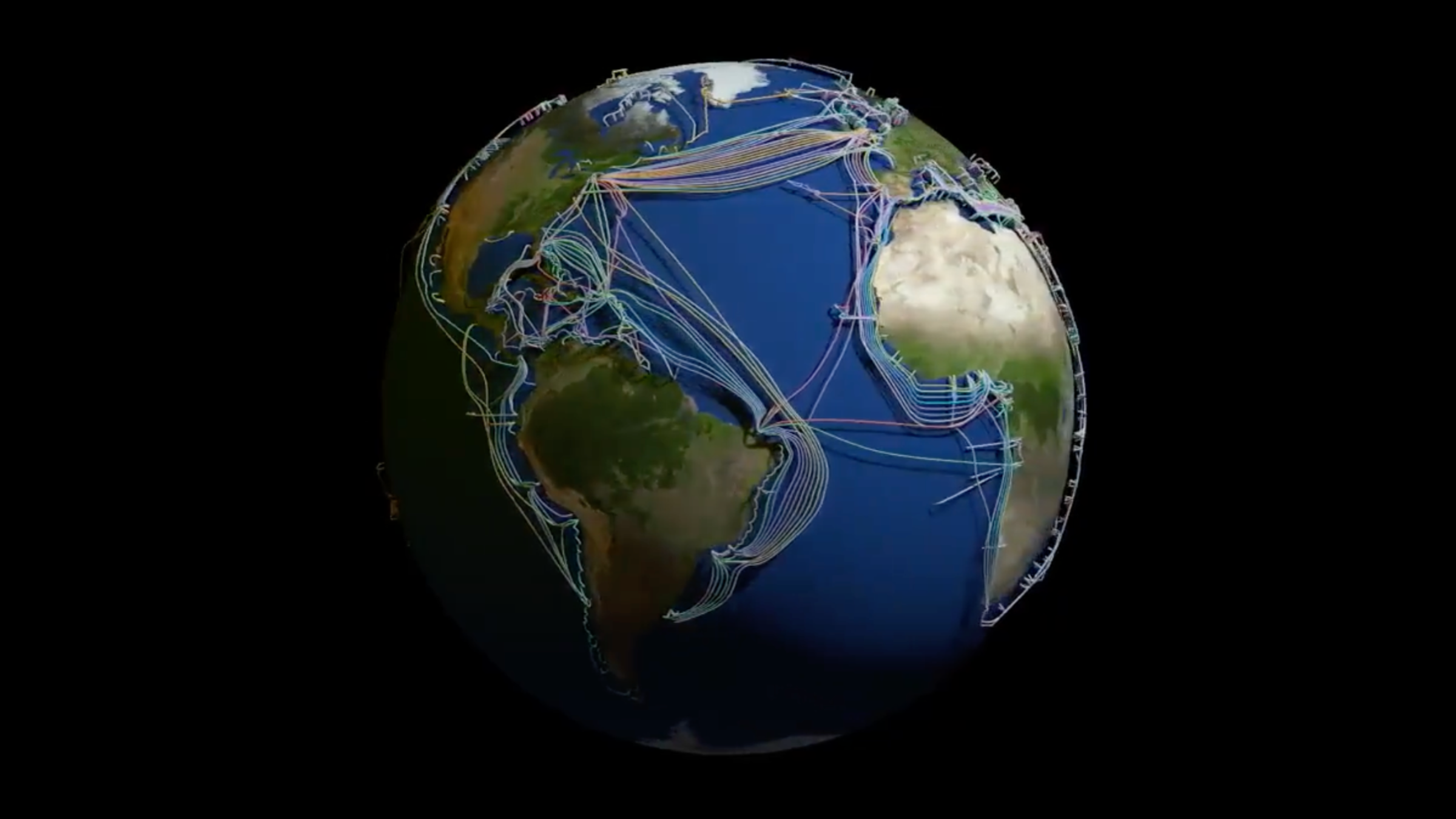In August 2020, U.S. Secretary of State Mike Pompeo launched his plan for the “Clean Network.” The State Department envisioned creating an alliance of “clean” countries and companies that would follow the United States in its aim to constrain the growth and competitiveness of the Chinese tech sector. They would exclude Chinese components from their telecom networks, ban the sale of devices from Chinese brands, and even start blocking their citizens’ access to Chinese apps and services.
Once Joe Biden took power the following year, his administration ditched the racist name of the initiative, but kept the main thrust of what it was trying to achieve. Gone were the days when the internet was supposed to be open and whatever form it took had to be embraced by countries, companies, and users alike, lest they be accused of suppressing digital rights or opposing free speech. As the United States saw its tech industry facing real competition, it was reacting; not by embracing the free market principles it had pushed on everyone else, but by trying to corral its allies into a new bloc that would agree to remain under the boot of Silicon Valley to forward the United States’ geopolitical aim of thwarting the rise of the Chinese tech companies.
In essence, the US approach told the world it needed to choose: either you’re part of the “clean” world of democratic US technology or the “dirty” and dangerous alternative marked by the authoritarian tech of China. Forget that whatever side you’re on, companies are looking for the optimal way of extracting the most profit from you by harvesting your data, locking you into their walled gardens, and limiting your actual power over the technology you use. An initiative to protect the market power of Silicon Valley was repositioned as being about defending Western democracy and liberal values — part of the usual US playbook.
But that’s a pretty terrible choice to have to make. Why should we have to choose between Amazon and Alibaba or Google and Baidu — especially the vast majority of the world that is neither American nor Chinese? Accepting that binary is not the road to a better future of technology or for our societies more broadly, as that trajectory is defined by an exploitative vision for what digital technology must be to maximize power and profit. As US technological hegemony declines, the better path is to reject the choice it’s trying to force on the world and forge a new one centered around entirely different values.
Rejecting the US-China binary
For years, internet advocates have warned against restrictive policies by governments like those in China and Russia aimed at limiting access to specific content online. They said initiatives like the Great Firewall risked ushering in an internet that was increasingly balkanized into different spheres where users will have very different experiences of the web based on where they are. The “splinternet,” as some call it, was to be avoided at all costs, but maybe it’s time to reconsider that stance; maybe it’s time to embrace it.
The open internet as we once knew it was always a product of US hegemony. As the network went global, cloaked in narratives of free speech and democracy, US tech companies rode the wave to establish themselves in international markets before domestic competitors could effectively compete, then got US diplomatic support to ensure they wouldn’t be strictly regulated. As Senator Al Gore declared to the US Senate in 1989, “the nation which most completely assimilates high-performance computing into its economy will very likely emerge as the dominant intellectual, economic, and technological force in the next century.” A few years later, he would become vice president and advance the commercialization and eventually privatization of the internet.

The consequences of that policy are now being felt, and even US allies are becoming openly frustrated with how Silicon Valley firms now dominate significant parts of their economies and they’re limited in how they can respond without drawing the ire of the United States. Part of the reason China has been able to buck the trend and develop a tech industry that can rival Silicon Valley is precisely because it didn’t accept the US rulebook. While the Great Firewall does have a strong censorship component, at its core it’s a tried-and-true economic policy: by keeping out foreign competition, it gave its domestic tech companies the space to grow and improve their capacities to the point where they can go global like their US counterparts. It’s similar to what South Korea and Japan did decades ago to build up their electronics and automotive industries — though they did it with US permission.
As the United States turns to protectionism and an embrace of the kind of policies it would’ve spurned less than a decade ago, the true nature of its internet policy is being put on full display. It was never about the liberal ideals it wrapped the internet in, but was always about maximizing the power of its tech firms and the benefits the US state could accrue from them. Despite Silicon Valley’s libertarian rhetoric, there was a mutual benefit among tech leaders and the US government to see Silicon Valley go global, including everything from economic gains to the intelligence benefits enabled by its vast surveillance apparatus. In recent years, that’s become openly formalized as Silicon Valley has used (and arguably campaigned to advance) the hysteria against Chinese tech to forge closer alliances with the US defense industry and security state.
Seen through this light, the binary choice the United States is trying to force onto the world isn’t a particularly appealing one — not for US citizens, and especially not for those of other nationalities where governments have even less power to hold US tech companies accountable. An alternative to what the United States is offering doesn’t mean simply embracing Chinese tech or building national champions that still follow the same extractive model guiding the development of both, but wholly challenging the dynamics that have shaped the growth of the global tech industry for the past several decades.
A proposal for a collective splinternet
If we’re make a serious case for a splinternet, the central plank should be the elimination of massive global platforms like we’ve gotten used to over the past couple decades. Governments will have to use regulatory and legal tools to erode the power and influence of those firms, squeezing their business models by restricting the ways they can use and collect data and enforcing much stronger rules on their operations. Higher taxes wouldn’t hurt either — something the US has been holding up globally for years. Regulation of global firms can be hard when undertaken by a single state on the national level, which is why it’s so important to start building an alliance of states that refuse the binary choice being offered by the United States — and rein in both US and Chinese tech giants with sectoral rules.
At the same time as regulatory pressures escalate, governments will need to think about what alternatives look like. This is where forced interoperability and open protocols come in, as long as they’re paired with regulatory measures and efforts to build public technology. Users will still want to communicate and share things with people they know from around the globe, and they should still be able to do that. But access to those federated services should instead happen through platforms conceived of and developed on the regional, national, or even local level. That will allow governments and communities to exert much more power over how they work and what they deem acceptable on them — instead of leaving it to a global monopoly or a tech-savvy group that has technical skill few other people hold — and given the different rules and cultural contexts of different countries, the choices they make may differ.
For example, we’re already seeing a growing effort to regulate social media as governments acknowledge the consequences of the previous hands-off approach. Some might see that as curbing fundamental rights, particularly US internet advocates and foreign activists who’ve picked up their conception of free speech. But many countries do not have the same approach to free expression and tolerate greater enforcement. In Brazil, lawmakers want Twitter to respect its ruling to suspend far-right users involved in an attempted coup, while Australia wants it to take down videos of a recent stabbing at a church. Elon Musk has been resisting both, using “free speech” as a justification to protect right-wing accounts. The Australian case, in particular, will be an important test of the power of national governments outside the United States to regulate tech platforms. It wants the stabbing videos removed entirely, not just hidden from Australian users.

Developing those alternative platforms shouldn’t just be left to private companies. In the same way many countries have always recognized an important role for public broadcasters, it’s time to reject the neoliberal consensus that’s dominated the internet and create public bodies whose job it is to develop technology in the public interest — not to serve founders or shareholders. The most exciting proposal I’ve seen in this vein is the British Digital Cooperative that Dan Hind conceived of in 2019. In his vision, a public cooperative would be established to build not just a public social media platform, but non-profit alternatives for payment processing, office software, and other digital services people depend on to cut out the rentiers. It wouldn’t just have a central office in the capital city, but would set up centers — something like libraries, maybe even connected to them — throughout the country to provide access to technology and public education, while building software and services to meet the needs of their communities.
Building on Hind’s vision, the social media platform could be connected to that federated network, so it aligns with the values of the country or community that builds it, but other jurisdictions can have their cooperatives shape their platform to align with their needs — while still being able to communicate with everyone else connected to the service. There’s also the possibility of setting up alliances between cooperatives on bigger projects like office software and any number of wider technological initiatives to pool resources for the collective good, whether domestically or internationally.
Internationalism would have to be a key part of this movement as well — not simply developing a new model that a small number of countries uses to extract economic returns from others, as is currently the case. In 2020, Juan Ortiz Freuler called for a digital non-aligned movement of countries in the Global South who could chart a different technological path, taking inspiration from the countries that rejected the pressure to embrace US capitalism and Soviet Communism during the Cold War. Given that some countries will have more resources, their work should be shared with — not sold to — countries with fewer resources as their public cooperatives deploy services that meet the needs of their citizens. Countries in this alliance could also share learnings from the successes and failures of their regulatory efforts to develop more effective means of reining in the existing tech monopolists.
Not all of that work will be able to happen on the local or national level though; there will need to be some degree of international governance given communications infrastructure does cross borders and exists within international waters. Inspiration could be taken from the Universal Postal Union, a UN agency that’s been around since 1874 to manage the global postal system and regulate international postage rates. A Universal Internet Union could manage the network of undersea cables that connect the world, instead of leaving it to private companies (and increasingly tech monopolists), and the transfer of public technologies and software for the common good. This would be a very different conception for how we govern the internet and the development of digital technology — but that’s exactly what we need right now.
Take back control of technology
Embracing the splinternet won’t be without its challenges. Surely, tech libertarians whose narratives have shaped how people understand the internet since its commercialization will find a slew of problems with any plan to increase the role of government — even as many of them continue not to acknowledge the role their ideas played in enabling the corporate takeover of the internet and the many problems that followed. The bigger issue comes down to incentives and economics though.
The tech policy of many of our governments is currently guided by maximizing economic returns. Even when they talk about reining in the tech monopolies, they’re usually still hesitant to challenge the deeper model that drives the industry because of all the money tech firms can pull in. Europe has been lauded for its tech regulation in recent years, but much of it has been focused on putting restrictions on US tech firms so it can raise its own exploitative national champions that may go on to command massive valuations of their own — not to challenge the underlying model. But rejecting the binary choice offered by the United States and embracing an alternative will require just that: to sacrifice economic returns in favor of democratic control and social gains.
One of the great things about such a model is how it could wrest the centralization of technological development from Silicon Valley and a small number of other hubs around the world to make it something much more democratic and aligned with public and community needs rather than the interests of venture capitalists and the stock market. In the same way that many countries have domestic media industries — often supported by public funding — a collective splinternet allows us to imagine a world where US tech monopolies are pushed out so local innovation can become a tangible goal in a way it hasn’t since Silicon Valley’s global conquest.
Is the splinternet a perfect proposal? I’m sure it has its flaws. But Silicon Valley has had too much power over how we think about and relate to technology for too long, and simply giving Shenzhen a greater hand in it isn’t the path forward. The US-China tech rivalry offers a rare opportunity for us to look clearly at the technological reality we’ve been sold and to refuse the bargain being put on the table. Instead, an alliance can be formed that imagines a very different social and technological future that tells US tech billionaires to get lost, gives countries greater sovereignty over the technological choices they make, and promotes a much more distributed approach to innovation.
Three decades into the commercialized internet, it’s time to take back control.












Member discussion